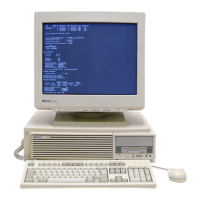A special Option
001
deletes the Ethernet cable
stripper
and
the N-Type Crimp Tool. This option is
recommended
when
there is more
than
one installed
network
per
site.
RJE Interface
(UP
27122A)
The
RJE
interface,
used
in conjunction with the
RJE
software
(97077
A
or
97087
A)
under
HP-UX, allows the
HP
9000
Series
500
to emulate
an
IBM
2780
or
3780
workstation. It permits the Series
500
to be
used
as a
Remote Job Entry station for batched job communication
with
IBM
360/370 (or other compatible) computers using
the
IBM
Bisync protocol.
The
RJE
interface features a plug-in card incorporating
microprocessor intelligence that offloads all
communications overhead from the host. This means the
interface card performs all protocol generation
and
interpretation, as well as
modem
control tasks
and
pre-processing functions such as character conversion,
blocking
and
deblocking.
The specific
needs
of
many
different
RJE
applications
are
met
by
selecting programmable configuration
parameters.
Full trace log, communications status
and
statistics, as
well as hardware self-test, are provided to facilitate
complete monitoring
and
check-out of the interface.
Features
•
1200
to
19200
baud
rates
• Compatible
with
EIA RS-232C
and
CCITT V.24
specifications
• Supports
Bell
type
208B,
2096
and
212
data sets or
equivalent
• Supports Seimens
MSV2
protocol
• Works
with
full or half duplex
modems
and
supports
AUTO ANSWER
and
ORIGINATE
• Provides link control functions: line bid, normal
and
transparent data modes, all responses,
and
link
termination
• Assures data integrity with CRC error checking
• EBCDIC character recognition
• Space compression/truncation
Operation
The
RJE
interface works with
modems
(or
modem
eliminators) over switched
or
non-switched lines. The
maximum data rate supported by the interface is 19.2
Kbps
but
it also operates at slower rates to accommodate
different modems.
Link control is managed entirely
by
the on-card
microprocessor.
All
functions
and
responses
(ACKINAKI
W ACKITTD/RVI) are implemented
by
the card
upon
request by software from the Series 500.
Card parameters
and
special character handling may
be configured from the
HP
9000
Series
500
or allowed to
retain their default values. Configurable parameters
include: record
and
block sizes, timeouts, retry counts,
conversion tables, record separators
and
formatting
functions. Special character handling includes: character
code translation, automatic record terminations, adding
and
stripping, record
and
block separator sequences,
blank truncating
and
padding,
and
repeated character
compression
and
expansion.
9
To
assist in line quality
and
link troubleshooting, the
RJE
interface card accumulates communication statistics.
A continuous trace log can collect all sent-or-received link
control characters
and
independently collect all
sent-or-received data characters. You can review the link
control character trace log without having access to
the
data character trace log,
thus
permitting link trouble
shooting without violating data security. A trace log also
collects all internal firmware state changes.
The
RJE
interface does not recognize horizontal
tabulation
and
vertical forms control codes. This
capability
must
be host-resident.
Specifications
Max. current requirements
..
+
5V
= 1.62
Amps
+
12V
= .087
Amps
-12V
= .108
Amps
Dimensions
................
172.7mm (6.8 in.) long
172.0mm (7.75 in.) wide
Weight
....................
Interface Card:
Environmental
235
grams (8.3 oz.)
Modem
Cable:
560
grams (19.7 oz.)
requirements . . . . . . . . . . Operating temperature:
0°
-
55°C
Operating humidity:
5%
-
95%
RH @
4Q°C
Operating altitude:
4600
metres (15,000 ft.)
Shared Resource Manager Interface
(UP
27123)
The
HP
27123
Shared Resource Management
(SRM)
Interface allows
an
HP
9000
Series
500
HP-UX system or
BASIC
Language System to interconnect to
an
HP
SRM
system.
The SRM system consists of a dedicated Series
200
controller that manages
shared
peripherals
and
a
hierarchical
file
system
on
a shared disc connected to it.
BASIC, Pascal,
and
HP-UX workstations are linked to the
SRM controller via SRM cables
and
multiplexers. The
benefits of
an
SRM system are cost savings by sharing
peripheral devices
and
the
convenience of being able to
access common information
on
a
shared
disc from
multiple workstations.
HP
9000
Series
500
BASIC Language systems can
perform the same mass storage operations to the SRM
disc that are available with a local disc, except for system
boot.
HP-UX systems can copy files from the local HP-UX
disc to the SRM disc
and
vice versa.
• Cable Specifications
• The
HP
272123A Interface is connected to the SRM
system by
any
of the following SRM cables:
• 97061A -
10
Metres
•
97061B
-
25
Metres
•
97061
C -
60
Metres
• 970610 -
60
Metres (unterminated
on
one
end
to
facilitate pulling cable
thru
cable trays.)
Refer to the
HP
9000
Data Communications Technical
Supplement (Publication
Number
5953-4692)
for detailed
configuration
and
ordering information concerning the
SRM system.

